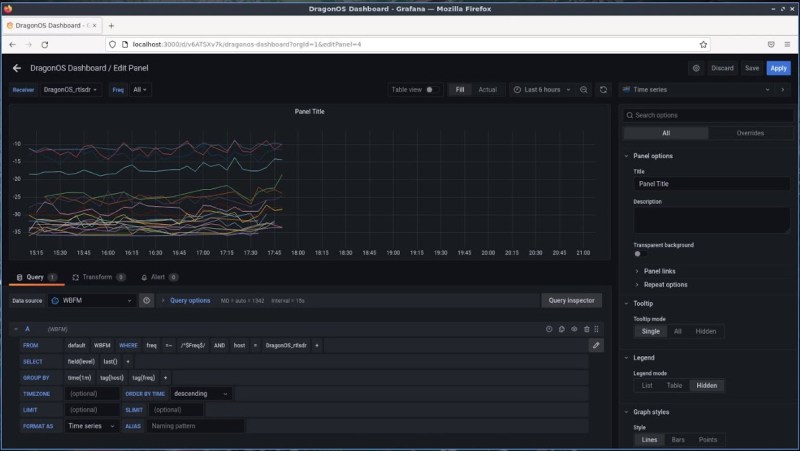DragonOS, a Debian-based Linux distribution specifically packaged for software-defined radio functionality, roared onto the wavelengths during the beginnings of the various pandemic lockdowns last year. Since then [Aaron], the creator of the OS, has been busy adding features to the distribution as well as creating plenty of videos which show off its capabilities and also function as how-tos for people who might want to learn about software-defined radio. The latest is a video about using this software to detect radio signals in certain specified spectrums.
This build uses two RTL-SDR devices paired with the DragonOS software suite to automatically detect active frequencies within a specified frequency range and that aslo exceed a threshold measured above the average noise floor. The video includes the setup of the software and its use in detecting these signals, but also includes setup of influxdb and Grafana which provide logging capabilities as well. Using this setup, multiple receivers either local or over the internet can then be configured to dump all the identified frequencies, powers, and time stamps into DragonOS.
[Aaron] has also been helping developers to build the SDR4space.lite application which includes GPS support, so he hopes that in a future video a user will be able to easily associate location to identified frequencies. Projects like these also serve as a reminder that getting into software-defined radio is as easy as buying a $10 USB radio receiver and configuring some free software to do anything that you can imagine like tracking ships and airplanes in real time.
















Its not Debian based, its based on Ubuntu.
… which based on Debian…
also^
Just because there aren’t a truckload of comments (yet?) doesn’t mean this article is wasted.
I’m interested in pursuing DragonOS for mine.
I’d be interesting in seeing just how ubiquitous SDR really is.
Thanks for this! Been looking for something like this for a while.
What sdr device is 10$. Also it says it logs does that include an audio recording too for say police scanner?
Something like this: https://www.ebay.com/itm/RTL2832U-R820T2-USB-2-0-Digital-DVB-T-SDR-DAB-FM-HDTV-Tuner-Receiver-Stick-LIST-/353667523903
Logs DO NOT
DragonOS is a great way to get started with SDR, removes one of the toughest challenges when getting started which is getting a known good setup!
Im actually in the process of building a detacated machine for SDR running Dragon OS. I think it’s wonderfully setup. A true gem.
:%s/aslo/also/g
The thing that seems to get glossed over in most of the SDR hype, is that you *do* need some RF circuitry ahead of the ADC. From what I’ve picked up on, at the low end of the price scale (e.g. $10), the devices you can get are pretty lacking in that RF section.
It would seem to me that anyone who is handy with RF wouldn’t really need anything more than an adequate ADC .. and of course the s/w support downstream of that. Which is where this custom OS might come in handy. So the weakest link for someone taking first steps into SDR, someone who has RF tec and a spare PC, is that ADC.
What would constitute an adequate ADC? This could spark a huge discussion. Just to throw something at the wall, how about 10MS/s, 16 bits resolution, two channels of that (for I and Q).
When I look around for ADC chips, just raw ADC chips, it seems like those specs can easily be hit for under $10. But that’s just a naked chip. The ideal piece of hardware would mount that on a module with buffered analog inputs and a USB connection. (I realize that the ADC’s digital side would probably be SPI or I2C, and that going USB implies a 2nd chip, undoubtedly a microcontroller, to bridge that gap)
Modules that fit that description can be found. Problem seems to be marketing spin. If you go on audiophile sites, 10MS/s @ 16 bits is way more than you need for audio, so you encouter high prices. If you look for ‘data acquisition’ modules, you find places that specialize in working with academic and industrial labs that aren’t shy about 4 digit price tags. If you look for ‘USB oscilloscopes’, things are a little better, you find high sample rates and medium-low (e.g. $50-$75) price tags, but O-scopes tend to work in 8bits/sample, which might be a bit low for SDR work. Or you find modules that only do 100S/s.
I guess my point is, it feels like there’s a niche here, for a decent (enough for SDR) ADC that you can plug into a USB port. Leave off the crummy RF section. Just a nice orthogonal building block. Hard to believe such a thing can’t be found.
An SDR is more than an adc. There’s generally a quadrature LO and an IQ mixer too.
Without these elements, you’re stuck at a bandwidth of your sample rate around DC. I.e., a 10MS/s ADC gets you from DC to 10MHz.
As soon as you add a mixer, then you need to disambiguation side bands, hence quadrature LO and two mixers. The tuner chips in the RTL SDRs aren’t really much more than that (there’s some variable gain too, etc).
So I think the RTL SDR is already as close to what you’re looking for as can be found inexpensively. The “missing front end” on most SDRs (even fancy, expensive ones like from Ettus) is mainly filtering and switching because that’s very application specific thing, and would make the devices less general purpose.